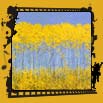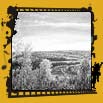 Heritage Community Foundation Presents
Heritage Community Foundation PresentsAlberta Online Encyclopedia
 |
 |
 |
|||
     |
Legacy Article "Master of Light and Sky" Sylvain Voyer's studio is nothing special. A flat light bounces in from a grey cement wall just outside the window and infuses a place so generic, it could be anywhere. But the brilliant yellow field under a crisp band of blue floating in the centre of the room is anything but generic. That has to be Alberta.
In a painting career which has produced canvases representing "a few thousand places,"
Voyer typically marshals the absolute clarity of the Alberta parkland air into a visual precision.
He creates a world so crystalline, the leaves sparkle in a faint breeze you can almost feel passing by.
"I go for an intensity of experience. If my physical reaction to the light, the dynamics of the colours, the forms, the excitement of the relationships is translated strongly enough, it is passed directly to the viewer," explains the quiet-spoken Voyer, a laid-back foil to his vibrant paintings. He is aware of the challenge facing all Alberta landscape painters, in our technologically attuned society. "I am using paint—not light, so I have to ask myself, can I achieve the electric, vibrational quality? I set that task of trying to achieve as close to light with paint as possible." So what keeps him coming back to the land? What forces propel him to hunt for rolling countryside when the rest of the world seems intent on scanning computer screens for truth and beauty? Voyer points out the obvious—the landscape is never the same. It changes from year to year, teasing, taunting the artist into an ongoing dialogue. It's a seduction not unlike that experienced by the early explorers who were enticed north. "Painting here still captures that historical northern ideal of going out into the landscape. Searching for and discovering a place to paint is somewhat of an adventure. I paint for aesthetic pleasure and I do respond emotionally. Since I was a kid, I've got an 'art high' from the landscape. I'm drawn to a certain place by the light and topography. This spring was especially wet and what attracted me were the sloughs of water and how they dot the landscape. I'm drawn to the different nature of each spring." Sure enough, in a new piece, several puddles dot the landscape and set up a restless swirl, while the sky is reflected in a mirror of micro ponds. The elliptical or spiral composition allows the rhythm of the place to override the painting's structure. "I think abstractly. I'm after simplicity, with subtleties and nuances," he explains as he points out summer-bright contrasts or winter dramas of dark against light in unframed canvases stacked against a studio wall. Voyer clearly recognizes that approaching the spacious landscape as if it were an abstract subject, with full use of modernist colour theory, is the secret to capturing sky-filled Aberta. He is well-placed for the task, with his family ties back to 1893 in Edmonton. "I paint here because my roots are here. My introduction to painting landscape was in the Mill Creek Ravine area in Edmonton." Always a 'plein-air' painter, one who paints directly on location, Voyer was earlier known for small paintings which captured the big feeling of the landscape and sky near Edmonton. In those days, he would bicycle to a site and paint his easily portable works.
In 1972, he and painter/photographer, Harry Savage founded Latitude 53, an artist-run centre, still operating today. By choosing Edmonton's geographic latitude for the gallery's name, the two artists underlined their dedication to creating art of and from a specific place, not imported from elsewhere. "An important element for me is a focus on the specific—a specificity of place." Voyer says. "Many of my paintings look so different because they are different experiences, capturing a certain light, a particular place, an unmistakable season. One of the primary things about a place is its identity." However, all contemporary landscape painters face a growing dilemma. Their depictions all too often remain as a legacy of a place no longer to be found. As Voyer puts it, "Sometimes a favorite spot gets changed because of growing urbanism." There are no power poles in Voyer's world. No rusted car bodies. No sanitary landfills. In some ways, he focuses on what could be and not always on what is. But if Alberta is defined by its light and sky, that, at least, seems untouched. Using multiple, white undercoatings and surface glazes, he recreates the famous Alberta light, making him as much a painter of skyscapes as of landscapes. "The sky has become the most abstract part of the painting. To retain a lightness of touch, that quality is important to me as a painter. Now my approach is 'zen-like/ with action and reaction, intuition and emotion." In the past Voyer has said, "I think what draws me to paint the sky is that it's theatre. It's changing. It's always a new sky, a new time, a new formation, a new .cloud. It can go from the dramatic to the sublime to the poetic to the dreary." His approach reaches back to 19th century European Romanticism and Impressionism, as well as to the early 20th century Canadian Group of Seven. His contemporary style is tempered by his own artistic time and place, with the latest new painting materials at his disposal and with his modernist practice of painting in series. "I want each painting to fit into a larger continuum. I want a series of related paintings to always have a feeling of surprise or excitement. One thing that attracts me to a landscape is its structure and how I can organize that into an exciting composition or a stimulating idea. That pleasure principle is part of what the paintings are about. I want lots of pleasant surprises." However, along with the surprising and the exceptional, it's Voyer's exploration of what we take for granted that sticks. He maps a unique landscape. It's a radiant place where sky and earth are equal, shimmering partners in a complex duet. And whatever happens to the land, the sky goes on, much like a river, always changing, sometimes weeping, ever renewed. In our visually loaded environment, an escape to the countryside can be a welcome rest. Over time we recognize that the land is as rich in detail as any urban scene. We slowly become aware that walking across a field, under the immense dome of sky, viewing the unapproachable horizon rise and fall with each step, is a powerfully energizing Alberta experience. And even though Voyer leaves us with the impression that he carefully paints every detail his eye picks up along his personal journey across one of those fields, ours is a landscape that can absorb a great deal and still retain a sense of vast space. Through his paintings, we can make our own armchair journey of discovery into the north, to another time and place, back to ourselves, to our roots. Elizabeth Beauchamp is a freelance writer specializing in visual arts issues. |
|
|||
|
|
|||||
|
Copyright © 2003 Heritage Community Foundation All Rights Reserved |
|||||
 |
 |
 |
For more on Alberta's Arts Heritage, visit Peel’s Prairie Provinces.




